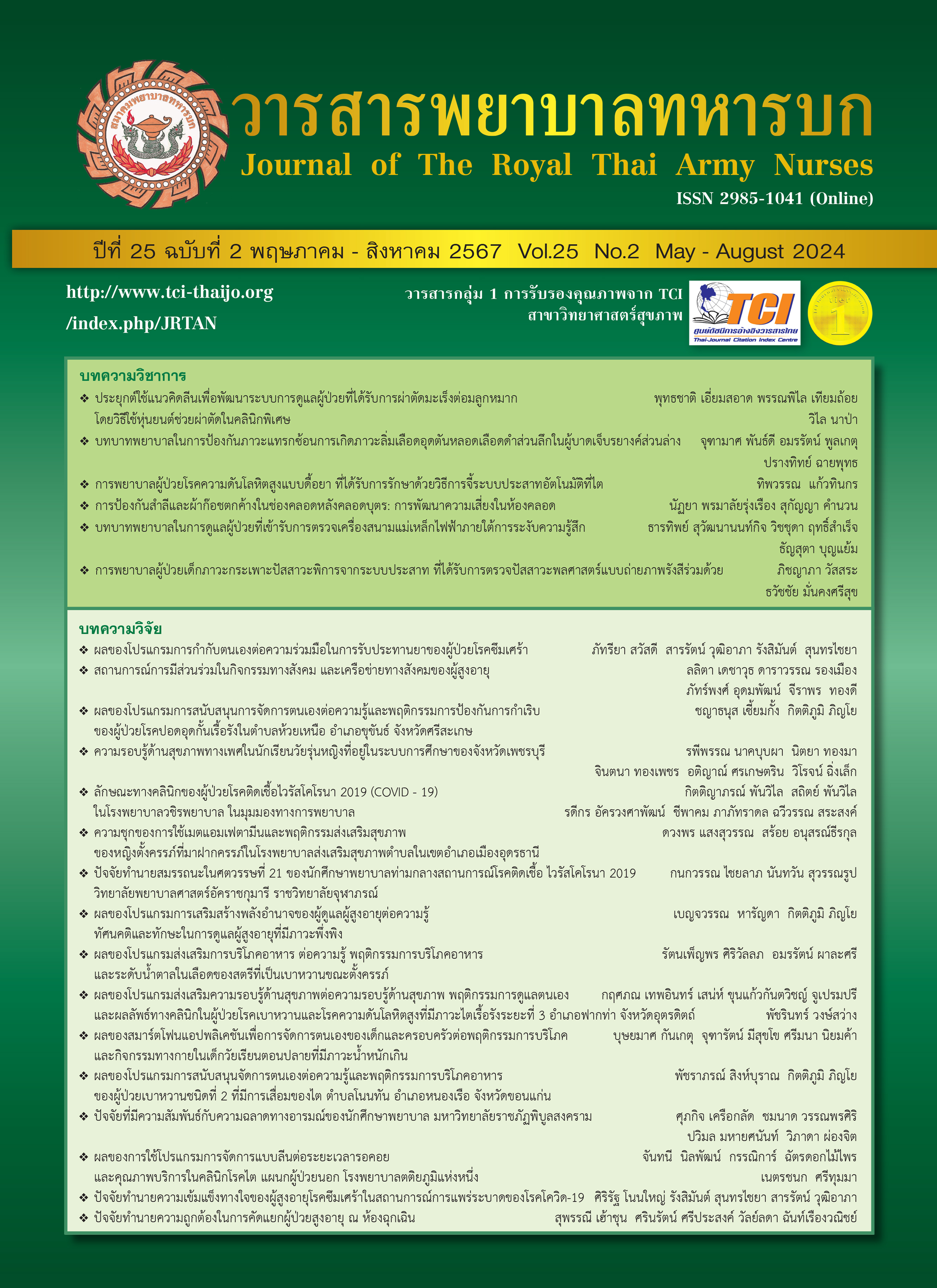Prevalence of Methamphetamine Use and Health Promotion Behaviors among Pregnant Women at Antenatal Clinic of the Subdistrict Health Promotion Hospital in Mueang Udonthani District
Keywords:
Methamphetamine, Health promotion behaviors, Pregnant women, Ante-natal careAbstract
This descriptive research aimed to study the prevalence of methamphetamine use and health promotion behaviors level and compare health promotion behaviors of pregnant women who use and do not use methamphetamine. The sample consisted of 289 pregnant women who came for antenatal care at the Subdistrict Health Promoting Hospital, Mueang Udonthani District. The tool used was a health promotion behavior evaluation with six aspects: responsibility for health, nutrition, interpersonal relationships, spiritual development, and stress management. Index of item objective congruence (IOC) was .71–1 The overall Cronbach’s alpha coefficient was .98. The descriptive statistics were used and the t-test.
The results found that 17.6% of the sample used methamphetamine. Most samples using methamphetamine had overall health promotion behaviors at a low level (76.5%, and each aspect was at a low level, including responsibility for health and stress management. Most of the other aspects were at a moderate level. The group that did not use methamphetamine had overall health promotion behaviors at a moderate level, and each aspect was at a high level. The overall health promotion behavior and each aspect of the sample who did not use methamphetamine were better than those who used methamphetamine and statistically significant (p<.001, 95%, CI 4.82-65.24).
Recommendations: Every antenatal care service should include a history of substance use and health promotion behavior to provide appropriate assistance and referrals.
Downloads
References
.Drug Prevention and Suppression Office. Performance of drug prevention and suppression, fiscal year 2020. Bangkok, Ministry of Justice; 2020. (in Thai)
Thaithammayanon P, Punnahitanon S, Chanson P, Sirisap A. Common newborn problems: basic solutions. Bangkok: Thana Place; 2016. (in Thai)
Delivery room, Udonthani Hospital. Birth statistics and counseling on methamphetamine use. Udonthani: Udonthani Hospital; 2021. (in Thai)
King IM. A theory for nursing: systems, concepts, process. New York: John Wiley & Sons; 2007.
Chaiverapundech J, & Kanchanabat S. Prenatal methamphetamine exposure and neonatal outcomes. Vajira Medical Journal: Journal of Urban Medicine 2016; 60 (1): 53-64. (in Thai)
Robert R, Michael FG, Charles JL, Joshua AC, Thomas RM, Robert MS. Substance abuse in pregnancy. 8thed, Philadelphia: Elsevier; 2019.
Thamkhantho M. Obstetric outcomes of amphetamine misapplication duration pregnancy. Journal of the Medical Association of Thailand 2018; 101(12): 1680-5. (in Thai)
Committee Opinion. Methamphetamine abuse in women of reproductive age. Obstetrics and Gynecology 2011; 117(479): 751-5.
Cunningham FG, Lenovo JK, Bloom SL, Dashe JS, Hoffman BL, Casey BM, et al. Williams obstetrics. 25thed. New York: McGraw-Hill; 2018.
Waiketkarn A. Obstetrical and neonatal outcomes in maternal exposure to methamphetamine during pregnancy. Mahasarakham Hospital Journal 2021; 18(2): 105-11. (in Thai)
Buranasak J, Hungsawanus P, Raiva W, Pungbangkadee R, Khadking N. The effects of health promotion program for teenage pregnancy on total gestational weight gain and infant birth weight. Journal of The Royal Thai Army Nurses 2020; 21(2): 434-42. (in Thai)
Seeherunwong, A., Yuttatri, P. Associated factors of illegal drug abuse and dependence behaviors among defenders under compulsory drug treatment system. Journal of the Psychiatric Association of Thailand 2015; 58(4): 371–84.
Tachavijitjaru C. Health literacy: a key indicator towards good health behavior and health outcomes. Journal of The Royal Thai Army Nurse. 2018; 19 (Supplement): 1-11. (in Thai)
Kittirattanaphaiboon P, Preechawit S. Guidelines for detecting and treating pregnant women who use drugs. Bangkok: Research Center for Alcohol Problems and the Health Promotion Office; 2019. (in Thai)
Alcohol Problems Research Center. Guidelines for detecting and treating pregnant women who use drugs or have abnormal substance use behavior. Songkhla: Faculty of Medicine, Prince of Songkla University; 2019. (in Thai)
Murdaugh CL, Parsons MA, Pender NJ. Health promotion in nursing practice. 8thed. USA: Pearson Education; 2019.
Cochran WG. Sampling techniques. 3rded. Canada: John Wiley & Sons; 1977.
Srisawad K, Panyapinitnukul C, Sonnark N. Health-promoting behavior in pregnancy. Songklanagarind Journal of Nursing 2018; 38(2): 95-109. (in Thai)
Bloom BS. Taxonomy of education. New York: David McKay Company; 1975.
Inthawiwat S. Drugs in pregnant women. Bangkok: Faculty of Medicine Siriraj Hospital, Mahidol University; 2015. (in Thai)
Karalai S, Sriratanaprapat J. Relationships between social support and health-promoting behavior among pregnant teenagers. The Journal of Faculty of Nursing Burapha University 2018; 26(1): 1-10. (in Thai)
Tamteangtrong R, Sangin S, Deoisres W. Factors predicting nutritional health-promoting behaviors among pregnant adolescents. The Journal of Faculty of Nursing Burapha University 2017; 25(1): 49-60. (in Thai)
Winalaivanakoon C. Selected factors related to health responsibility behaviors among pregnant adolescents in Amnat Charoen Province. Journal of Nursing, Siam University 2017; 20(39): 8-19. (in Thai)
Disapirom T, Chareonsanti J, Sriarporn P. Factors related to health promotion behaviors regarding nutrition among adolescent pregnant women. Nursing Journal 2019; 46 (3): 157-68. (in Thai)
Downloads
Published
How to Cite
Issue
Section
License
Copyright (c) 2024 Journal of The Royal Thai Army Nurses

This work is licensed under a Creative Commons Attribution-NonCommercial-NoDerivatives 4.0 International License.
บทความหรือข้อคิดเห็นใดใดที่ปรากฏในวารสารพยาบาลทหารบกเป็นวรรณกรรมของผู้เขียน ซึ่งบรรณาธิการหรือสมาคมพยาบาลทหารบก ไม่จำเป็นต้องเห็นด้วย
บทความที่ได้รับการตีพิมพ์เป็นลิขสิทธิ์ของวารสารพยาบาลทหารบก
The ideas and opinions expressed in the Journal of The Royal Thai Army Nurses are those of the authors and not necessarily those
of the editor or Royal Thai Army Nurses Association.






